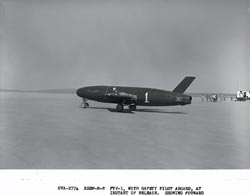|
 The success of the crude German V-1 “buzz bomb” and the more sophisticated V-2 ballistic missile did not go unnoticed by the world’s military powers. Near the end of World War II the USS Barb (SS220) and USS Seahorse (SS304) had used 5-inch rocket launchers to bombard military and industrial targets on the Japanese home island from 4500 yards (2.6 miles) offshore. The success of the crude German V-1 “buzz bomb” and the more sophisticated V-2 ballistic missile did not go unnoticed by the world’s military powers. Near the end of World War II the USS Barb (SS220) and USS Seahorse (SS304) had used 5-inch rocket launchers to bombard military and industrial targets on the Japanese home island from 4500 yards (2.6 miles) offshore.
Military planners could easily foresee the end of conventional warfare and the birth of the new era of guided missile warfare.
From 1947 to 1953 the field of guided missile technology grew at a tremendous pace, with over 114 separate missile weapon systems contracted for as development projects during this period.
In 1945 BuAer (Navy Bureau of Aeronautics) turned with increased interest to surface-to-surface missiles, and published a 69-page report entitled “Study of Requirements for Pilotless Aircraft for Fleet use in 1950”. This report resulted in eighteen BuAer study contracts dispersed among twelve leading aircraft manufacturers. In October, 1945, BuAer invited Chance Vought to submit proposals for several P/A (pilotless aircraft). In June, 1946, Chance Vought Aircraft signed a study contract for a short range surface-to-surface P/A-6. This missile was to be powered by a ramjet engine (in the fashion of the German V-1 buzz bomb) that was yet to be fully developed and proven.
The Navy then opted for a different missile utilizing proven powerplant technology. On 21 May, 1947, Vought submitted an initial proposal for the new missile. In June, 1947, Vought submitted a complete proposal on the subsonic missile program. Two features of the proposal were unique and interesting to the Navy. First, Vought proposed a development program centered around a recoverable flight test vehicle using landing gear and a parabrake. The recoverability feature would greatly reduce the cost of flight test and development. Second, the flight test vehicle and the production tactical missile would differ as little as possible. Vought also suggested doubling the usual structural design safety factor and eliminating the structural testing for both the flight test and tactical missiles. BuAer agreed. (There were no instances where a Regulus I broke up in flight).
On 16 November 1947 BuAer issued a Letter of Intent to Vought for Contract NOa(s) 9450. On 28 November 1947 initial engineering design work was begun and on 23 December 1947 Chance Vought accepted the program contract. The Regulus program was begun. The missile was named for a first-magnitude star in the constellation Leo. In a similar fashion, another missile program of that period was named Rigel, a first-magnitude star in the left foot of the constellation Orion.
Vought and BuAer selected the Allison J-33 jet engine as the powerplant. This limited the missile’s performance but provided a proven engine and eliminated possible delays from an engine development program. Above all, the goal was to produce as quickly as possible a flight test vehicle that differed as little as possible with the tactical missile to follow.
From 1952 until contract termination in 1958, the Regulus missile program progressed from an experimental status to a fully operational weapon system. The Navy ultimately had the Regulus system installed on five missile submarines and eleven guidance submarines. During the cold war years the submarine fleet made 41 strategic deterrent patrols armed with Regulus, not ceasing operations until 14 July 1964.
Regulus:
Proposal Characteristics
ABLE, BAKER, CHARLIE and FTV-1
FTV-2
Operation SPLASH and FTV-3
Regulus I Sub-Systems
Regulus I and II
|